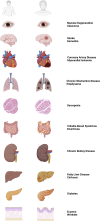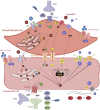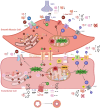Impact of aging on vascular ion channels: perspectives and knowledge gaps across major organ systems
- PMID: 37624095
- PMCID: PMC10908410
- DOI: 10.1152/ajpheart.00288.2023
Impact of aging on vascular ion channels: perspectives and knowledge gaps across major organ systems
Abstract
Individuals aged ≥65 yr will comprise ∼20% of the global population by 2030. Cardiovascular disease remains the leading cause of death in the world with age-related endothelial "dysfunction" as a key risk factor. As an organ in and of itself, vascular endothelium courses throughout the mammalian body to coordinate blood flow to all other organs and tissues (e.g., brain, heart, lung, skeletal muscle, gut, kidney, skin) in accord with metabolic demand. In turn, emerging evidence demonstrates that vascular aging and its comorbidities (e.g., neurodegeneration, diabetes, hypertension, kidney disease, heart failure, and cancer) are "channelopathies" in large part. With an emphasis on distinct functional traits and common arrangements across major organs systems, the present literature review encompasses regulation of vascular ion channels that underlie blood flow control throughout the body. The regulation of myoendothelial coupling and local versus conducted signaling are discussed with new perspectives for aging and the development of chronic diseases. Although equipped with an awareness of knowledge gaps in the vascular aging field, a section has been included to encompass general feasibility, role of biological sex, and additional conceptual and experimental considerations (e.g., cell regression and proliferation, gene profile analyses). The ultimate goal is for the reader to see and understand major points of deterioration in vascular function while gaining the ability to think of potential mechanistic and therapeutic strategies to sustain organ perfusion and whole body health with aging.
Keywords: K+ channels; TRP channels; endothelial function; myoendothelial coupling; vascular aging.
Conflict of interest statement
No conflicts of interest, financial or otherwise, are declared by the author.
Figures





Similar articles
-
Integration and Modulation of Intercellular Signaling Underlying Blood Flow Control.J Vasc Res. 2015;52(2):136-57. doi: 10.1159/000439112. J Vasc Res. 2015. PMID: 26368324 Free PMC article.
-
Conceptualizing conduction as a pliant electrical response: impact of gap junctions and ion channels.Am J Physiol Heart Circ Physiol. 2020 Dec 1;319(6):H1276-H1289. doi: 10.1152/ajpheart.00285.2020. Epub 2020 Sep 28. Am J Physiol Heart Circ Physiol. 2020. PMID: 32986968
-
Functional Interaction among KCa and TRP Channels for Cardiovascular Physiology: Modern Perspectives on Aging and Chronic Disease.Int J Mol Sci. 2019 Mar 19;20(6):1380. doi: 10.3390/ijms20061380. Int J Mol Sci. 2019. PMID: 30893836 Free PMC article. Review.
-
Endothelium-Dependent Hyperpolarization (EDH) in Hypertension: The Role of Endothelial Ion Channels.Int J Mol Sci. 2018 Jan 21;19(1):315. doi: 10.3390/ijms19010315. Int J Mol Sci. 2018. PMID: 29361737 Free PMC article. Review.
-
Transient receptor potential channels in the vasculature.Physiol Rev. 2015 Apr;95(2):645-90. doi: 10.1152/physrev.00026.2014. Physiol Rev. 2015. PMID: 25834234 Free PMC article. Review.
Cited by
-
Aging in Ocular Blood Vessels: Molecular Insights and the Role of Oxidative Stress.Biomedicines. 2024 Apr 8;12(4):817. doi: 10.3390/biomedicines12040817. Biomedicines. 2024. PMID: 38672172 Free PMC article. Review.
-
Microvascular endothelial dysfunction in vascular senescence and disease.Front Cardiovasc Med. 2025 Feb 18;12:1505516. doi: 10.3389/fcvm.2025.1505516. eCollection 2025. Front Cardiovasc Med. 2025. PMID: 40041173 Free PMC article. Review.
-
Endothelial Dysfunction: Redox Imbalance, NLRP3 Inflammasome, and Inflammatory Responses in Cardiovascular Diseases.Antioxidants (Basel). 2025 Feb 23;14(3):256. doi: 10.3390/antiox14030256. Antioxidants (Basel). 2025. PMID: 40227195 Free PMC article. Review.
-
Estrogen Enhances SK Channel Activity to Limit Hippocampal Arteriole Constriction.Circ Res. 2025 Aug;137(4):456-470. doi: 10.1161/CIRCRESAHA.125.326631. Epub 2025 Jun 26. Circ Res. 2025. PMID: 40567232
-
Immune system activation and cognitive impairment in arterial hypertension.Am J Physiol Cell Physiol. 2024 Dec 1;327(6):C1577-C1590. doi: 10.1152/ajpcell.00219.2024. Epub 2024 Nov 4. Am J Physiol Cell Physiol. 2024. PMID: 39495252 Free PMC article. Review.
References
Publication types
MeSH terms
Substances
Associated data
Grants and funding
LinkOut - more resources
Full Text Sources
Medical
Research Materials

